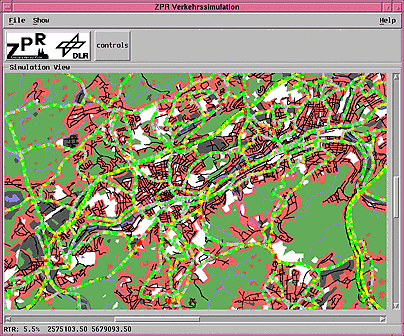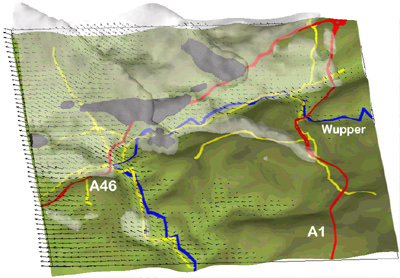
Trafficsimulation of Wuppertal/Germany (Detail)
Progress and development of modern societies are based on the mobility of goods and people. About 10% of the federal budget of Germany is used for the ministry of transport. It is known that most industrial countries spend a large percentage of their gross national product for mobility and transport facilities. In the USA this percentatge is about 14.8 %.

Trafficsimulation of Wuppertal/Germany (Detail)
Besides public transport based on combustion engine driven vehicles is one of the major factors in air pollution. In Germany traffic causes 67.9% of the carbon dioxide, 58.4% of the nitrogen oxide and 18.2% of the carbon monoxide emissions. Traffic contribution on the overall energy consumption is about 28%. In the discussion about man-made climate changings computer simulations are often used for etiology. It is obvious that control actions to correct the supposed reasons can be simulated and tested on efficiency in the same way. Simulation based on traffic models may be used not only as a decision aid but also as the basis for climatic models to estimate the potential effect of single measures to reduce air pollution.

NOx spread over Wuppertal calculated by the Institut for Geophysics and Meteorology at the University of Cologne with data from our traffic simulation
The traffic volume in the European Union is still rising. New statistic estimates assume that the overall traffic volume on european streets will double until the year 2010. It seems difficult or even improbable to make the necessary resources available in this period of time without evoking massive disturbances and impairments in other areas of life and economic sectors. For this simple reason it is necessary to avoid traffic as far as possible, optimize the inevitable and as the case may be displace it with new or more favourable transport systems.
Research-
partner")?>
Within the scope of our
traffic flow research and traffic simulation we work closely together
with different institutes and research institutions, for example:
Institut für Verkehrsforschung
(Deutsches Zentrum für Luft- und Raumfahrt)
ILUMASS (Integrated Land-Use Modelling and Transportation System Simulation)
SimVV - Simulation von Verkehrsverhalten
Forschungsverbund Verkehrsimulation und Umweltwirkungen NRW (NRW-FVU)
TRANISM Projekt
(Los Alamos National Lab)
More traffic")?> For detailled information about our traffic simulation please click: